Business and Business Environment Report: Types, Analysis & Impact
VerifiedAdded on 2023/01/19
|21
|5109
|86
Report
AI Summary
This report provides a comprehensive analysis of the business and its environment. It begins by classifying organizations into private, public, and voluntary sectors, detailing their purposes and legal structures, with examples like JCB, BBC, and Cancer Research UK. The report then examines the size and scope of these organizations, differentiating between micro, small, and medium enterprises, as well as international, multinational, global, and transnational companies. Further, it explores the interrelation between different organizational functions and the positive and negative impacts of the macro environment on business operations. The report also includes an internal analysis to identify strengths and weaknesses and their interrelation with external factors, culminating in a conclusion that summarizes the key findings.
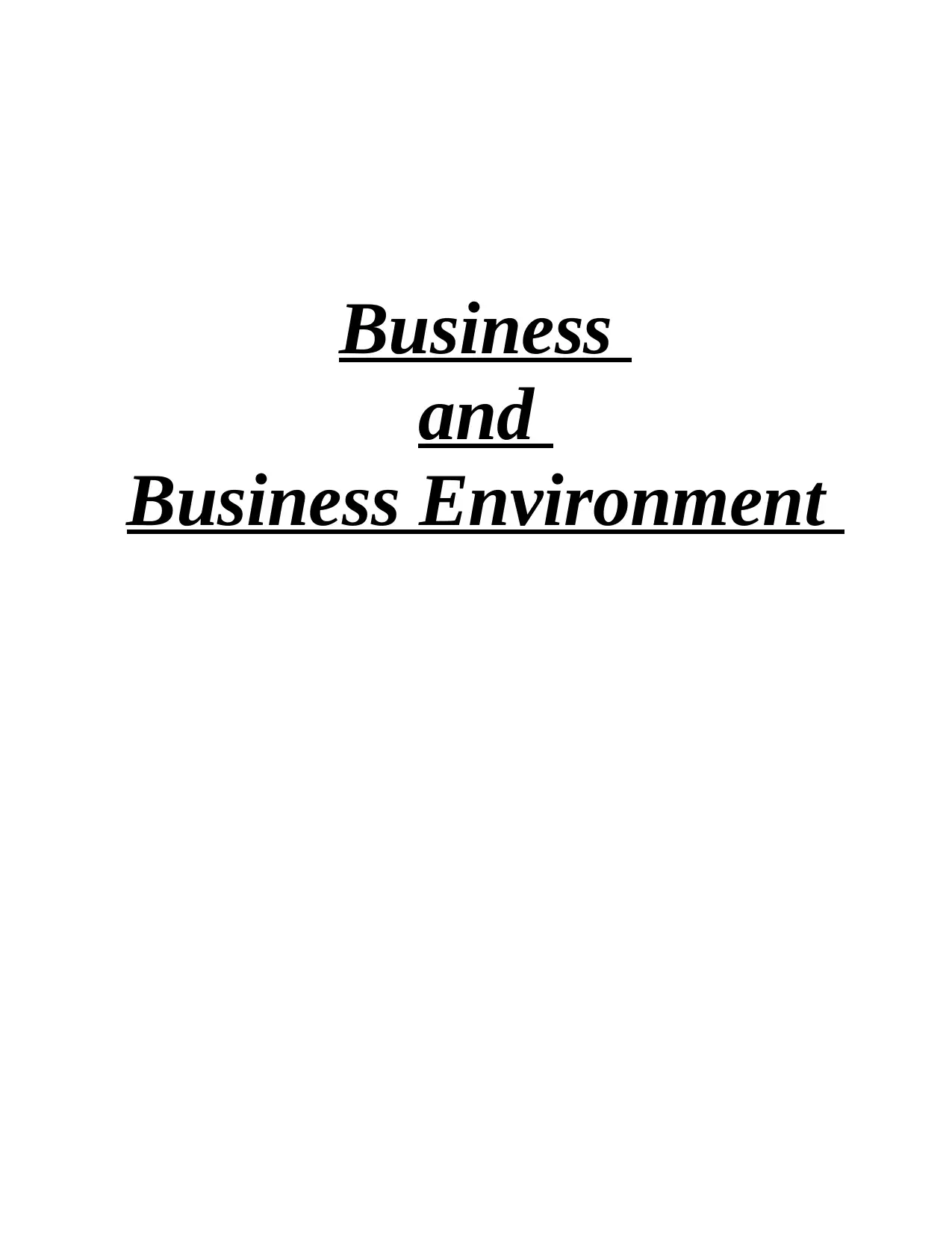
Business
and
Business Environment
and
Business Environment
Paraphrase This Document
Need a fresh take? Get an instant paraphrase of this document with our AI Paraphraser
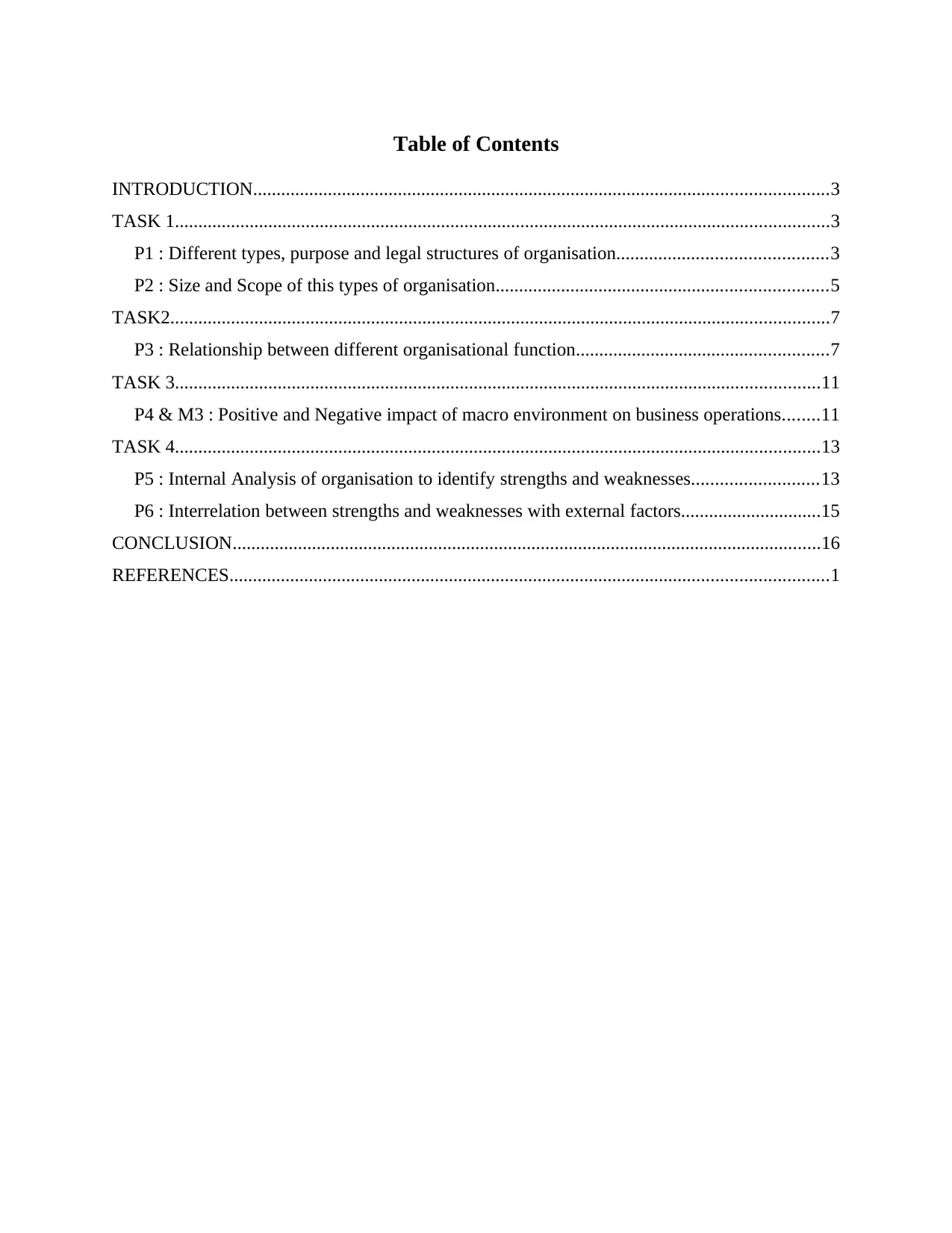
Table of Contents
INTRODUCTION...........................................................................................................................3
TASK 1............................................................................................................................................3
P1 : Different types, purpose and legal structures of organisation.............................................3
P2 : Size and Scope of this types of organisation.......................................................................5
TASK2.............................................................................................................................................7
P3 : Relationship between different organisational function......................................................7
TASK 3..........................................................................................................................................11
P4 & M3 : Positive and Negative impact of macro environment on business operations........11
TASK 4..........................................................................................................................................13
P5 : Internal Analysis of organisation to identify strengths and weaknesses...........................13
P6 : Interrelation between strengths and weaknesses with external factors..............................15
CONCLUSION..............................................................................................................................16
REFERENCES................................................................................................................................1
INTRODUCTION...........................................................................................................................3
TASK 1............................................................................................................................................3
P1 : Different types, purpose and legal structures of organisation.............................................3
P2 : Size and Scope of this types of organisation.......................................................................5
TASK2.............................................................................................................................................7
P3 : Relationship between different organisational function......................................................7
TASK 3..........................................................................................................................................11
P4 & M3 : Positive and Negative impact of macro environment on business operations........11
TASK 4..........................................................................................................................................13
P5 : Internal Analysis of organisation to identify strengths and weaknesses...........................13
P6 : Interrelation between strengths and weaknesses with external factors..............................15
CONCLUSION..............................................................................................................................16
REFERENCES................................................................................................................................1
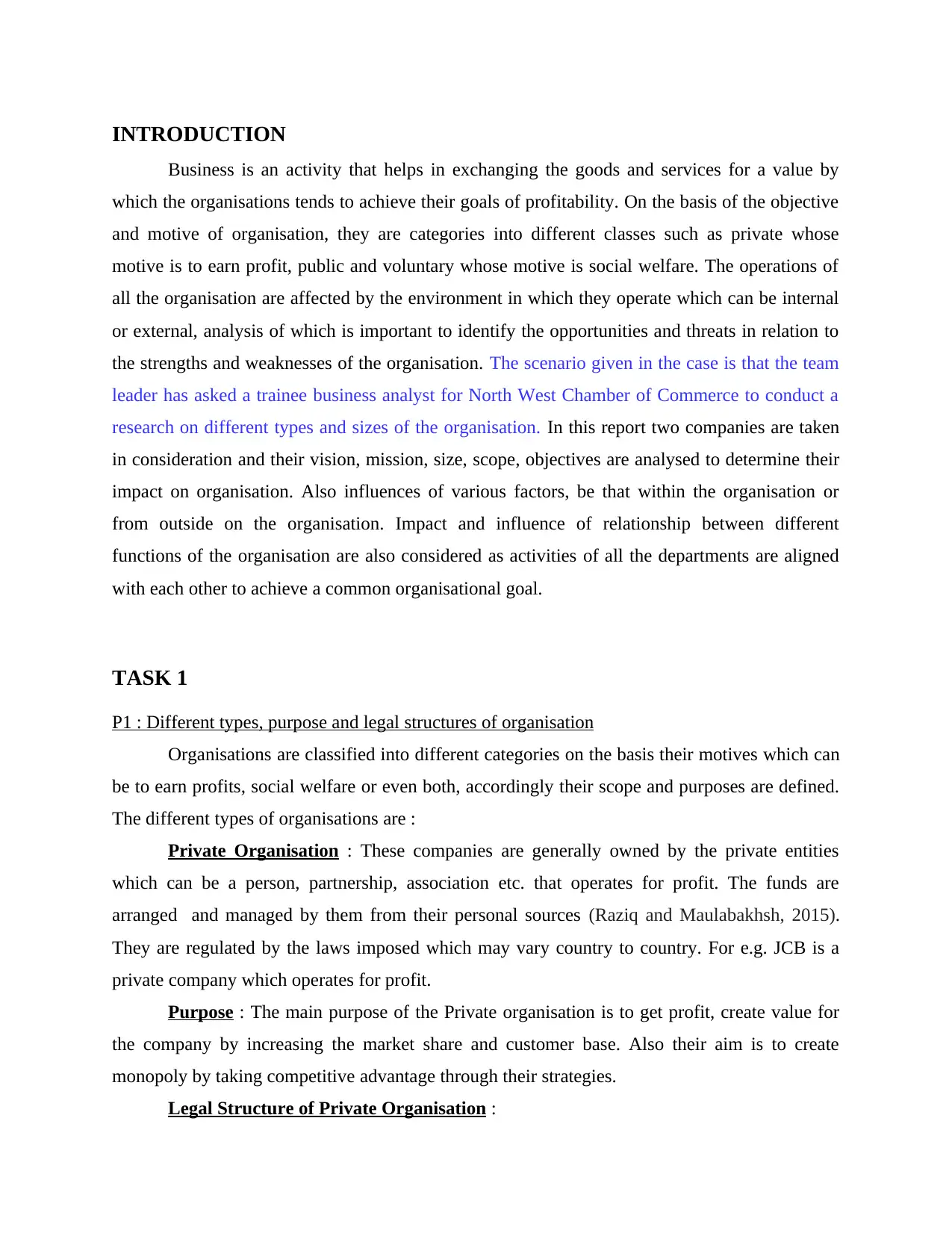
INTRODUCTION
Business is an activity that helps in exchanging the goods and services for a value by
which the organisations tends to achieve their goals of profitability. On the basis of the objective
and motive of organisation, they are categories into different classes such as private whose
motive is to earn profit, public and voluntary whose motive is social welfare. The operations of
all the organisation are affected by the environment in which they operate which can be internal
or external, analysis of which is important to identify the opportunities and threats in relation to
the strengths and weaknesses of the organisation. The scenario given in the case is that the team
leader has asked a trainee business analyst for North West Chamber of Commerce to conduct a
research on different types and sizes of the organisation. In this report two companies are taken
in consideration and their vision, mission, size, scope, objectives are analysed to determine their
impact on organisation. Also influences of various factors, be that within the organisation or
from outside on the organisation. Impact and influence of relationship between different
functions of the organisation are also considered as activities of all the departments are aligned
with each other to achieve a common organisational goal.
TASK 1
P1 : Different types, purpose and legal structures of organisation
Organisations are classified into different categories on the basis their motives which can
be to earn profits, social welfare or even both, accordingly their scope and purposes are defined.
The different types of organisations are :
Private Organisation : These companies are generally owned by the private entities
which can be a person, partnership, association etc. that operates for profit. The funds are
arranged and managed by them from their personal sources (Raziq and Maulabakhsh, 2015).
They are regulated by the laws imposed which may vary country to country. For e.g. JCB is a
private company which operates for profit.
Purpose : The main purpose of the Private organisation is to get profit, create value for
the company by increasing the market share and customer base. Also their aim is to create
monopoly by taking competitive advantage through their strategies.
Legal Structure of Private Organisation :
Business is an activity that helps in exchanging the goods and services for a value by
which the organisations tends to achieve their goals of profitability. On the basis of the objective
and motive of organisation, they are categories into different classes such as private whose
motive is to earn profit, public and voluntary whose motive is social welfare. The operations of
all the organisation are affected by the environment in which they operate which can be internal
or external, analysis of which is important to identify the opportunities and threats in relation to
the strengths and weaknesses of the organisation. The scenario given in the case is that the team
leader has asked a trainee business analyst for North West Chamber of Commerce to conduct a
research on different types and sizes of the organisation. In this report two companies are taken
in consideration and their vision, mission, size, scope, objectives are analysed to determine their
impact on organisation. Also influences of various factors, be that within the organisation or
from outside on the organisation. Impact and influence of relationship between different
functions of the organisation are also considered as activities of all the departments are aligned
with each other to achieve a common organisational goal.
TASK 1
P1 : Different types, purpose and legal structures of organisation
Organisations are classified into different categories on the basis their motives which can
be to earn profits, social welfare or even both, accordingly their scope and purposes are defined.
The different types of organisations are :
Private Organisation : These companies are generally owned by the private entities
which can be a person, partnership, association etc. that operates for profit. The funds are
arranged and managed by them from their personal sources (Raziq and Maulabakhsh, 2015).
They are regulated by the laws imposed which may vary country to country. For e.g. JCB is a
private company which operates for profit.
Purpose : The main purpose of the Private organisation is to get profit, create value for
the company by increasing the market share and customer base. Also their aim is to create
monopoly by taking competitive advantage through their strategies.
Legal Structure of Private Organisation :
⊘ This is a preview!⊘
Do you want full access?
Subscribe today to unlock all pages.

Trusted by 1+ million students worldwide
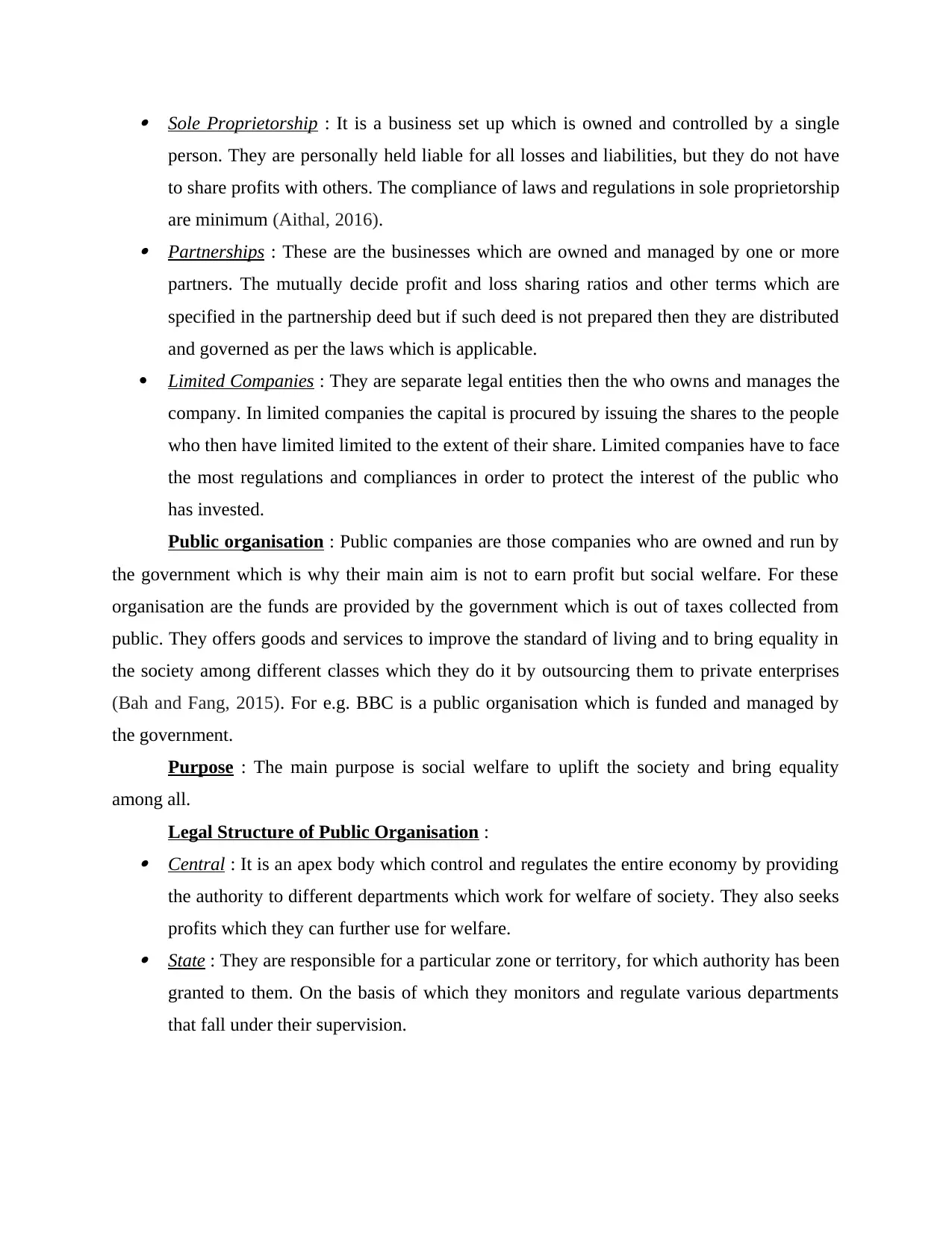
Sole Proprietorship : It is a business set up which is owned and controlled by a single
person. They are personally held liable for all losses and liabilities, but they do not have
to share profits with others. The compliance of laws and regulations in sole proprietorship
are minimum (Aithal, 2016). Partnerships : These are the businesses which are owned and managed by one or more
partners. The mutually decide profit and loss sharing ratios and other terms which are
specified in the partnership deed but if such deed is not prepared then they are distributed
and governed as per the laws which is applicable.
Limited Companies : They are separate legal entities then the who owns and manages the
company. In limited companies the capital is procured by issuing the shares to the people
who then have limited limited to the extent of their share. Limited companies have to face
the most regulations and compliances in order to protect the interest of the public who
has invested.
Public organisation : Public companies are those companies who are owned and run by
the government which is why their main aim is not to earn profit but social welfare. For these
organisation are the funds are provided by the government which is out of taxes collected from
public. They offers goods and services to improve the standard of living and to bring equality in
the society among different classes which they do it by outsourcing them to private enterprises
(Bah and Fang, 2015). For e.g. BBC is a public organisation which is funded and managed by
the government.
Purpose : The main purpose is social welfare to uplift the society and bring equality
among all.
Legal Structure of Public Organisation : Central : It is an apex body which control and regulates the entire economy by providing
the authority to different departments which work for welfare of society. They also seeks
profits which they can further use for welfare. State : They are responsible for a particular zone or territory, for which authority has been
granted to them. On the basis of which they monitors and regulate various departments
that fall under their supervision.
person. They are personally held liable for all losses and liabilities, but they do not have
to share profits with others. The compliance of laws and regulations in sole proprietorship
are minimum (Aithal, 2016). Partnerships : These are the businesses which are owned and managed by one or more
partners. The mutually decide profit and loss sharing ratios and other terms which are
specified in the partnership deed but if such deed is not prepared then they are distributed
and governed as per the laws which is applicable.
Limited Companies : They are separate legal entities then the who owns and manages the
company. In limited companies the capital is procured by issuing the shares to the people
who then have limited limited to the extent of their share. Limited companies have to face
the most regulations and compliances in order to protect the interest of the public who
has invested.
Public organisation : Public companies are those companies who are owned and run by
the government which is why their main aim is not to earn profit but social welfare. For these
organisation are the funds are provided by the government which is out of taxes collected from
public. They offers goods and services to improve the standard of living and to bring equality in
the society among different classes which they do it by outsourcing them to private enterprises
(Bah and Fang, 2015). For e.g. BBC is a public organisation which is funded and managed by
the government.
Purpose : The main purpose is social welfare to uplift the society and bring equality
among all.
Legal Structure of Public Organisation : Central : It is an apex body which control and regulates the entire economy by providing
the authority to different departments which work for welfare of society. They also seeks
profits which they can further use for welfare. State : They are responsible for a particular zone or territory, for which authority has been
granted to them. On the basis of which they monitors and regulate various departments
that fall under their supervision.
Paraphrase This Document
Need a fresh take? Get an instant paraphrase of this document with our AI Paraphraser
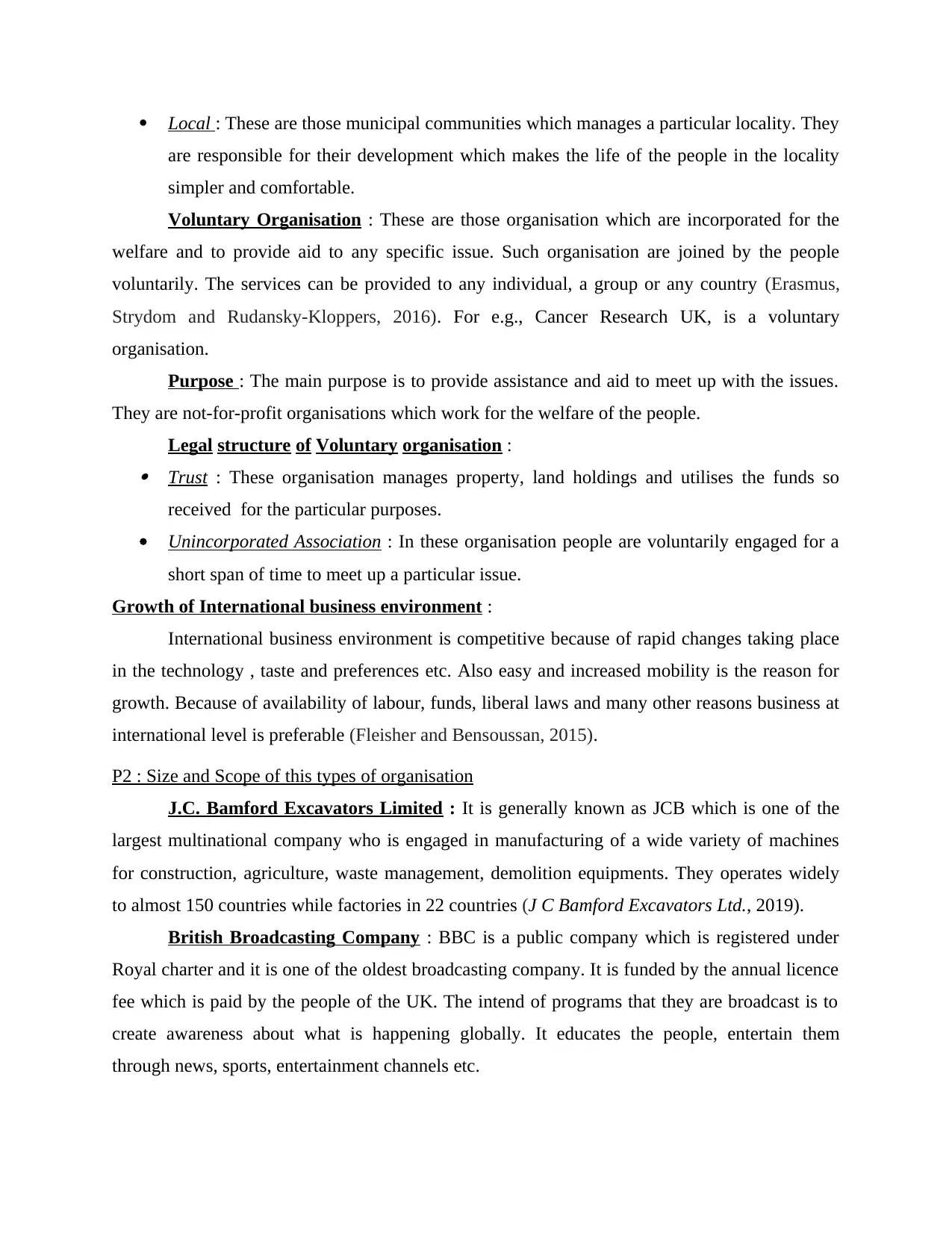
Local : These are those municipal communities which manages a particular locality. They
are responsible for their development which makes the life of the people in the locality
simpler and comfortable.
Voluntary Organisation : These are those organisation which are incorporated for the
welfare and to provide aid to any specific issue. Such organisation are joined by the people
voluntarily. The services can be provided to any individual, a group or any country (Erasmus,
Strydom and Rudansky-Kloppers, 2016). For e.g., Cancer Research UK, is a voluntary
organisation.
Purpose : The main purpose is to provide assistance and aid to meet up with the issues.
They are not-for-profit organisations which work for the welfare of the people.
Legal structure of Voluntary organisation : Trust : These organisation manages property, land holdings and utilises the funds so
received for the particular purposes.
Unincorporated Association : In these organisation people are voluntarily engaged for a
short span of time to meet up a particular issue.
Growth of International business environment :
International business environment is competitive because of rapid changes taking place
in the technology , taste and preferences etc. Also easy and increased mobility is the reason for
growth. Because of availability of labour, funds, liberal laws and many other reasons business at
international level is preferable (Fleisher and Bensoussan, 2015).
P2 : Size and Scope of this types of organisation
J.C. Bamford Excavators Limited : It is generally known as JCB which is one of the
largest multinational company who is engaged in manufacturing of a wide variety of machines
for construction, agriculture, waste management, demolition equipments. They operates widely
to almost 150 countries while factories in 22 countries (J C Bamford Excavators Ltd., 2019).
British Broadcasting Company : BBC is a public company which is registered under
Royal charter and it is one of the oldest broadcasting company. It is funded by the annual licence
fee which is paid by the people of the UK. The intend of programs that they are broadcast is to
create awareness about what is happening globally. It educates the people, entertain them
through news, sports, entertainment channels etc.
are responsible for their development which makes the life of the people in the locality
simpler and comfortable.
Voluntary Organisation : These are those organisation which are incorporated for the
welfare and to provide aid to any specific issue. Such organisation are joined by the people
voluntarily. The services can be provided to any individual, a group or any country (Erasmus,
Strydom and Rudansky-Kloppers, 2016). For e.g., Cancer Research UK, is a voluntary
organisation.
Purpose : The main purpose is to provide assistance and aid to meet up with the issues.
They are not-for-profit organisations which work for the welfare of the people.
Legal structure of Voluntary organisation : Trust : These organisation manages property, land holdings and utilises the funds so
received for the particular purposes.
Unincorporated Association : In these organisation people are voluntarily engaged for a
short span of time to meet up a particular issue.
Growth of International business environment :
International business environment is competitive because of rapid changes taking place
in the technology , taste and preferences etc. Also easy and increased mobility is the reason for
growth. Because of availability of labour, funds, liberal laws and many other reasons business at
international level is preferable (Fleisher and Bensoussan, 2015).
P2 : Size and Scope of this types of organisation
J.C. Bamford Excavators Limited : It is generally known as JCB which is one of the
largest multinational company who is engaged in manufacturing of a wide variety of machines
for construction, agriculture, waste management, demolition equipments. They operates widely
to almost 150 countries while factories in 22 countries (J C Bamford Excavators Ltd., 2019).
British Broadcasting Company : BBC is a public company which is registered under
Royal charter and it is one of the oldest broadcasting company. It is funded by the annual licence
fee which is paid by the people of the UK. The intend of programs that they are broadcast is to
create awareness about what is happening globally. It educates the people, entertain them
through news, sports, entertainment channels etc.
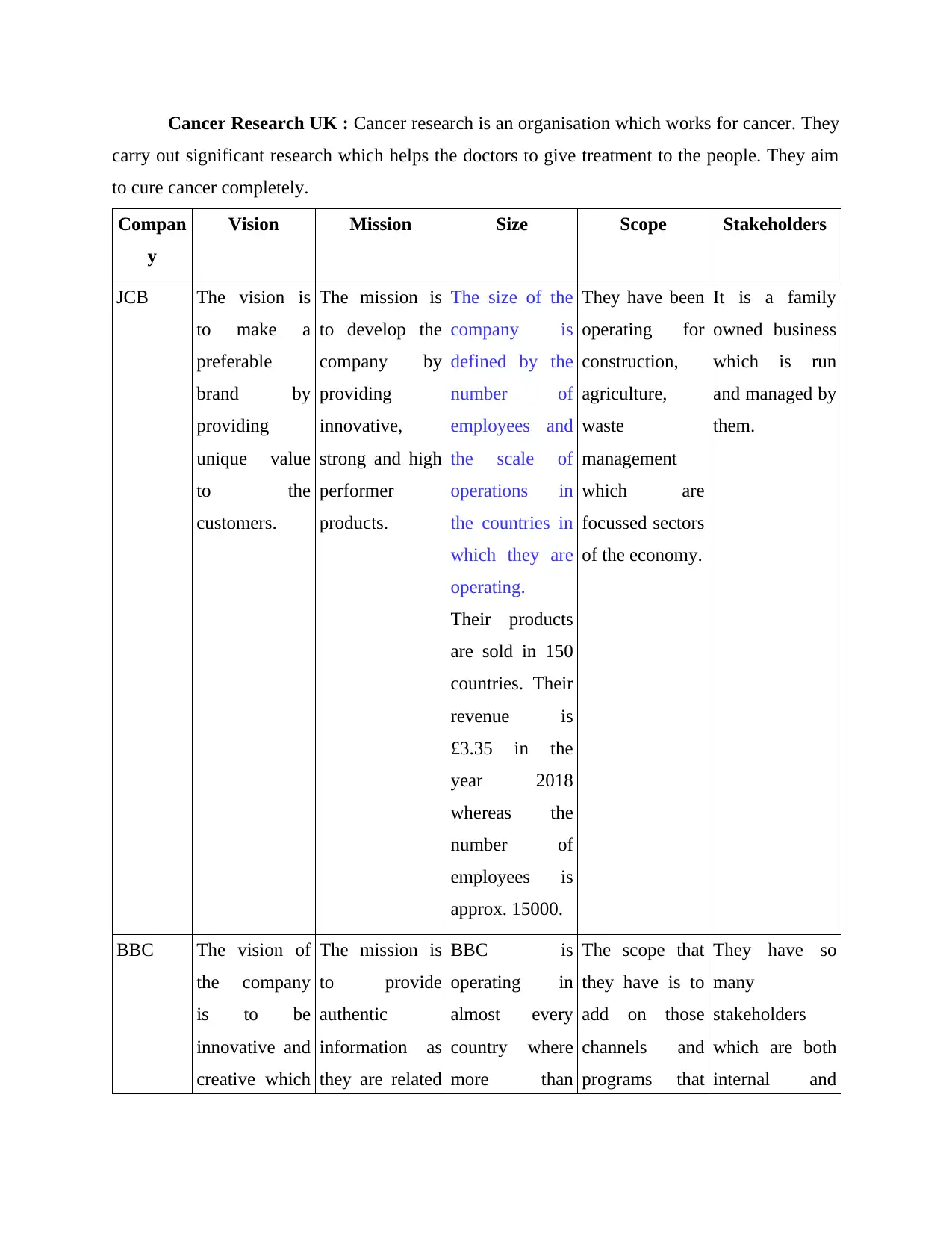
Cancer Research UK : Cancer research is an organisation which works for cancer. They
carry out significant research which helps the doctors to give treatment to the people. They aim
to cure cancer completely.
Compan
y
Vision Mission Size Scope Stakeholders
JCB The vision is
to make a
preferable
brand by
providing
unique value
to the
customers.
The mission is
to develop the
company by
providing
innovative,
strong and high
performer
products.
The size of the
company is
defined by the
number of
employees and
the scale of
operations in
the countries in
which they are
operating.
Their products
are sold in 150
countries. Their
revenue is
£3.35 in the
year 2018
whereas the
number of
employees is
approx. 15000.
They have been
operating for
construction,
agriculture,
waste
management
which are
focussed sectors
of the economy.
It is a family
owned business
which is run
and managed by
them.
BBC The vision of
the company
is to be
innovative and
creative which
The mission is
to provide
authentic
information as
they are related
BBC is
operating in
almost every
country where
more than
The scope that
they have is to
add on those
channels and
programs that
They have so
many
stakeholders
which are both
internal and
carry out significant research which helps the doctors to give treatment to the people. They aim
to cure cancer completely.
Compan
y
Vision Mission Size Scope Stakeholders
JCB The vision is
to make a
preferable
brand by
providing
unique value
to the
customers.
The mission is
to develop the
company by
providing
innovative,
strong and high
performer
products.
The size of the
company is
defined by the
number of
employees and
the scale of
operations in
the countries in
which they are
operating.
Their products
are sold in 150
countries. Their
revenue is
£3.35 in the
year 2018
whereas the
number of
employees is
approx. 15000.
They have been
operating for
construction,
agriculture,
waste
management
which are
focussed sectors
of the economy.
It is a family
owned business
which is run
and managed by
them.
BBC The vision of
the company
is to be
innovative and
creative which
The mission is
to provide
authentic
information as
they are related
BBC is
operating in
almost every
country where
more than
The scope that
they have is to
add on those
channels and
programs that
They have so
many
stakeholders
which are both
internal and
⊘ This is a preview!⊘
Do you want full access?
Subscribe today to unlock all pages.

Trusted by 1+ million students worldwide
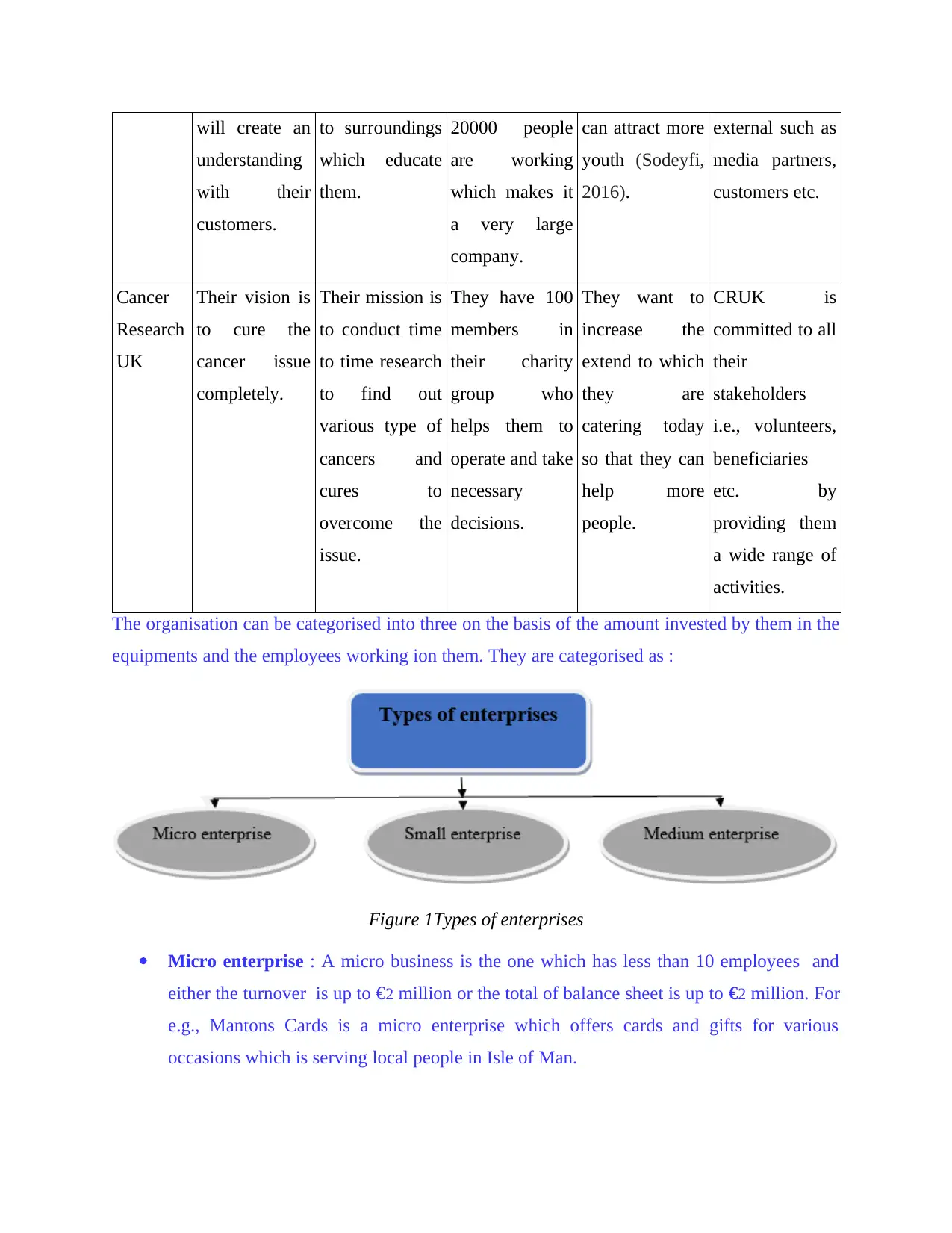
will create an
understanding
with their
customers.
to surroundings
which educate
them.
20000 people
are working
which makes it
a very large
company.
can attract more
youth (Sodeyfi,
2016).
external such as
media partners,
customers etc.
Cancer
Research
UK
Their vision is
to cure the
cancer issue
completely.
Their mission is
to conduct time
to time research
to find out
various type of
cancers and
cures to
overcome the
issue.
They have 100
members in
their charity
group who
helps them to
operate and take
necessary
decisions.
They want to
increase the
extend to which
they are
catering today
so that they can
help more
people.
CRUK is
committed to all
their
stakeholders
i.e., volunteers,
beneficiaries
etc. by
providing them
a wide range of
activities.
The organisation can be categorised into three on the basis of the amount invested by them in the
equipments and the employees working ion them. They are categorised as :
Figure 1Types of enterprises
Micro enterprise : A micro business is the one which has less than 10 employees and
either the turnover is up to €2 million or the total of balance sheet is up to €2 million. For
e.g., Mantons Cards is a micro enterprise which offers cards and gifts for various
occasions which is serving local people in Isle of Man.
understanding
with their
customers.
to surroundings
which educate
them.
20000 people
are working
which makes it
a very large
company.
can attract more
youth (Sodeyfi,
2016).
external such as
media partners,
customers etc.
Cancer
Research
UK
Their vision is
to cure the
cancer issue
completely.
Their mission is
to conduct time
to time research
to find out
various type of
cancers and
cures to
overcome the
issue.
They have 100
members in
their charity
group who
helps them to
operate and take
necessary
decisions.
They want to
increase the
extend to which
they are
catering today
so that they can
help more
people.
CRUK is
committed to all
their
stakeholders
i.e., volunteers,
beneficiaries
etc. by
providing them
a wide range of
activities.
The organisation can be categorised into three on the basis of the amount invested by them in the
equipments and the employees working ion them. They are categorised as :
Figure 1Types of enterprises
Micro enterprise : A micro business is the one which has less than 10 employees and
either the turnover is up to €2 million or the total of balance sheet is up to €2 million. For
e.g., Mantons Cards is a micro enterprise which offers cards and gifts for various
occasions which is serving local people in Isle of Man.
Paraphrase This Document
Need a fresh take? Get an instant paraphrase of this document with our AI Paraphraser
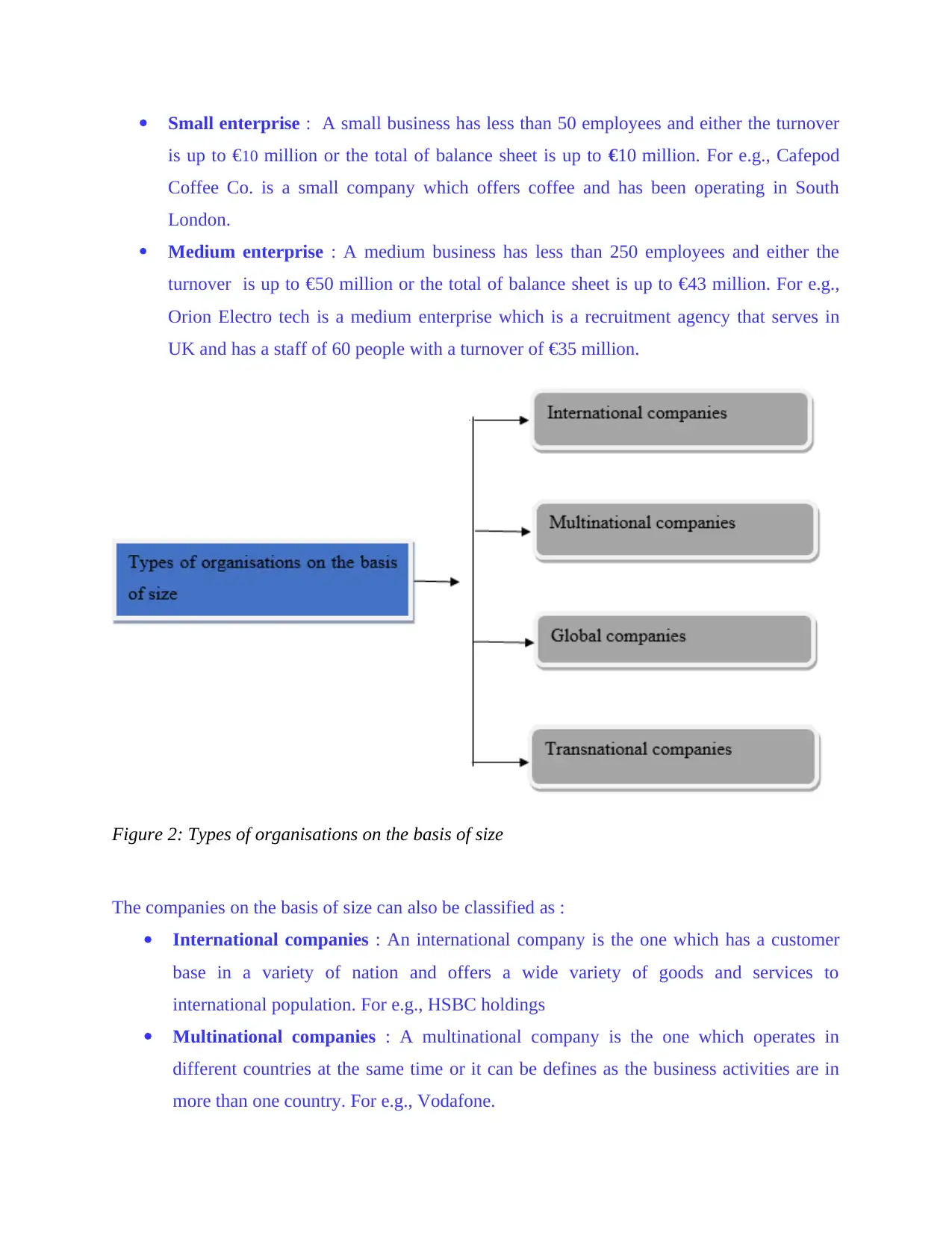
Small enterprise : A small business has less than 50 employees and either the turnover
is up to €10 million or the total of balance sheet is up to €10 million. For e.g., Cafepod
Coffee Co. is a small company which offers coffee and has been operating in South
London.
Medium enterprise : A medium business has less than 250 employees and either the
turnover is up to €50 million or the total of balance sheet is up to €43 million. For e.g.,
Orion Electro tech is a medium enterprise which is a recruitment agency that serves in
UK and has a staff of 60 people with a turnover of €35 million.
Figure 2: Types of organisations on the basis of size
The companies on the basis of size can also be classified as :
International companies : An international company is the one which has a customer
base in a variety of nation and offers a wide variety of goods and services to
international population. For e.g., HSBC holdings
Multinational companies : A multinational company is the one which operates in
different countries at the same time or it can be defines as the business activities are in
more than one country. For e.g., Vodafone.
is up to €10 million or the total of balance sheet is up to €10 million. For e.g., Cafepod
Coffee Co. is a small company which offers coffee and has been operating in South
London.
Medium enterprise : A medium business has less than 250 employees and either the
turnover is up to €50 million or the total of balance sheet is up to €43 million. For e.g.,
Orion Electro tech is a medium enterprise which is a recruitment agency that serves in
UK and has a staff of 60 people with a turnover of €35 million.
Figure 2: Types of organisations on the basis of size
The companies on the basis of size can also be classified as :
International companies : An international company is the one which has a customer
base in a variety of nation and offers a wide variety of goods and services to
international population. For e.g., HSBC holdings
Multinational companies : A multinational company is the one which operates in
different countries at the same time or it can be defines as the business activities are in
more than one country. For e.g., Vodafone.
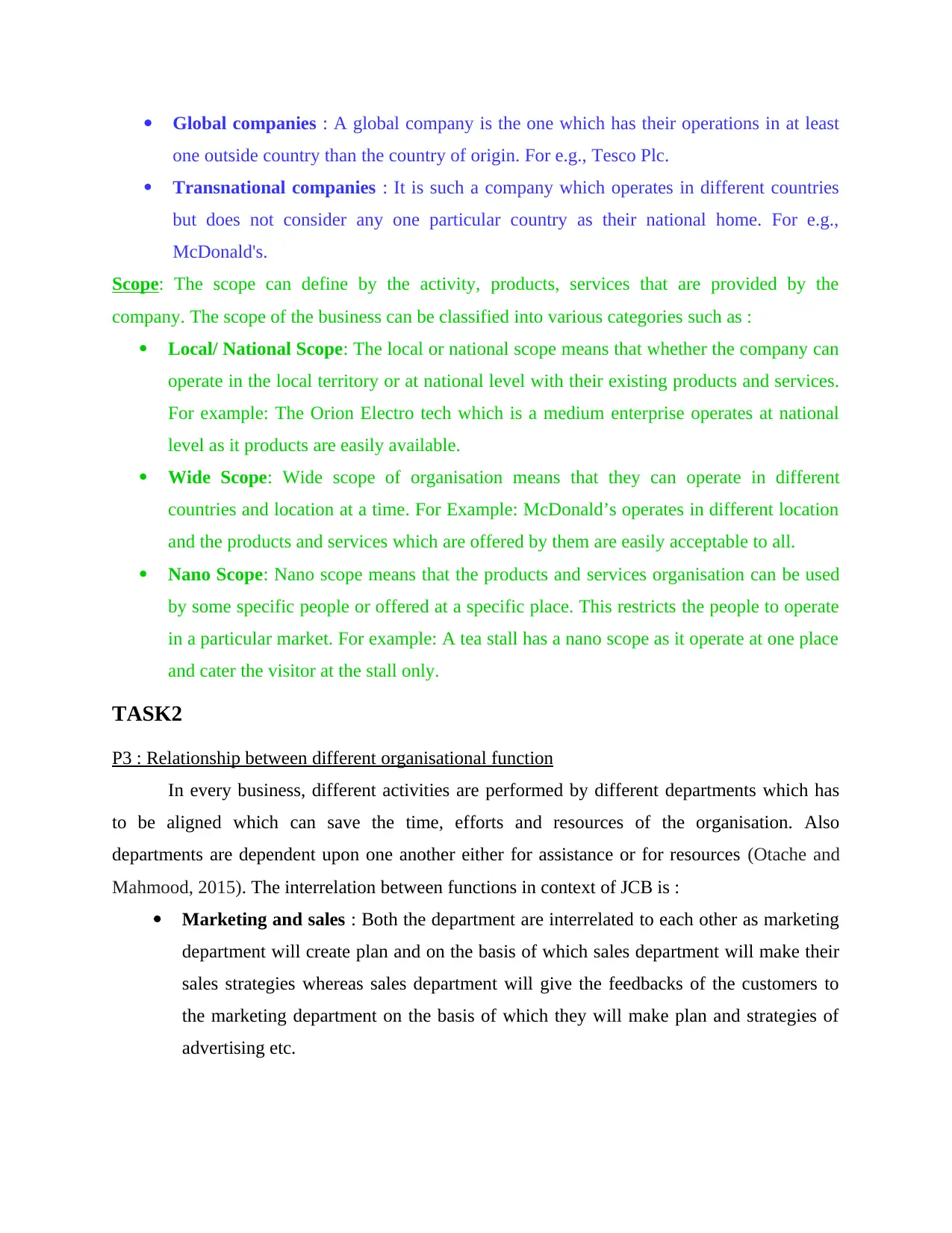
Global companies : A global company is the one which has their operations in at least
one outside country than the country of origin. For e.g., Tesco Plc.
Transnational companies : It is such a company which operates in different countries
but does not consider any one particular country as their national home. For e.g.,
McDonald's.
Scope: The scope can define by the activity, products, services that are provided by the
company. The scope of the business can be classified into various categories such as :
Local/ National Scope: The local or national scope means that whether the company can
operate in the local territory or at national level with their existing products and services.
For example: The Orion Electro tech which is a medium enterprise operates at national
level as it products are easily available.
Wide Scope: Wide scope of organisation means that they can operate in different
countries and location at a time. For Example: McDonald’s operates in different location
and the products and services which are offered by them are easily acceptable to all.
Nano Scope: Nano scope means that the products and services organisation can be used
by some specific people or offered at a specific place. This restricts the people to operate
in a particular market. For example: A tea stall has a nano scope as it operate at one place
and cater the visitor at the stall only.
TASK2
P3 : Relationship between different organisational function
In every business, different activities are performed by different departments which has
to be aligned which can save the time, efforts and resources of the organisation. Also
departments are dependent upon one another either for assistance or for resources (Otache and
Mahmood, 2015). The interrelation between functions in context of JCB is :
Marketing and sales : Both the department are interrelated to each other as marketing
department will create plan and on the basis of which sales department will make their
sales strategies whereas sales department will give the feedbacks of the customers to
the marketing department on the basis of which they will make plan and strategies of
advertising etc.
one outside country than the country of origin. For e.g., Tesco Plc.
Transnational companies : It is such a company which operates in different countries
but does not consider any one particular country as their national home. For e.g.,
McDonald's.
Scope: The scope can define by the activity, products, services that are provided by the
company. The scope of the business can be classified into various categories such as :
Local/ National Scope: The local or national scope means that whether the company can
operate in the local territory or at national level with their existing products and services.
For example: The Orion Electro tech which is a medium enterprise operates at national
level as it products are easily available.
Wide Scope: Wide scope of organisation means that they can operate in different
countries and location at a time. For Example: McDonald’s operates in different location
and the products and services which are offered by them are easily acceptable to all.
Nano Scope: Nano scope means that the products and services organisation can be used
by some specific people or offered at a specific place. This restricts the people to operate
in a particular market. For example: A tea stall has a nano scope as it operate at one place
and cater the visitor at the stall only.
TASK2
P3 : Relationship between different organisational function
In every business, different activities are performed by different departments which has
to be aligned which can save the time, efforts and resources of the organisation. Also
departments are dependent upon one another either for assistance or for resources (Otache and
Mahmood, 2015). The interrelation between functions in context of JCB is :
Marketing and sales : Both the department are interrelated to each other as marketing
department will create plan and on the basis of which sales department will make their
sales strategies whereas sales department will give the feedbacks of the customers to
the marketing department on the basis of which they will make plan and strategies of
advertising etc.
⊘ This is a preview!⊘
Do you want full access?
Subscribe today to unlock all pages.

Trusted by 1+ million students worldwide
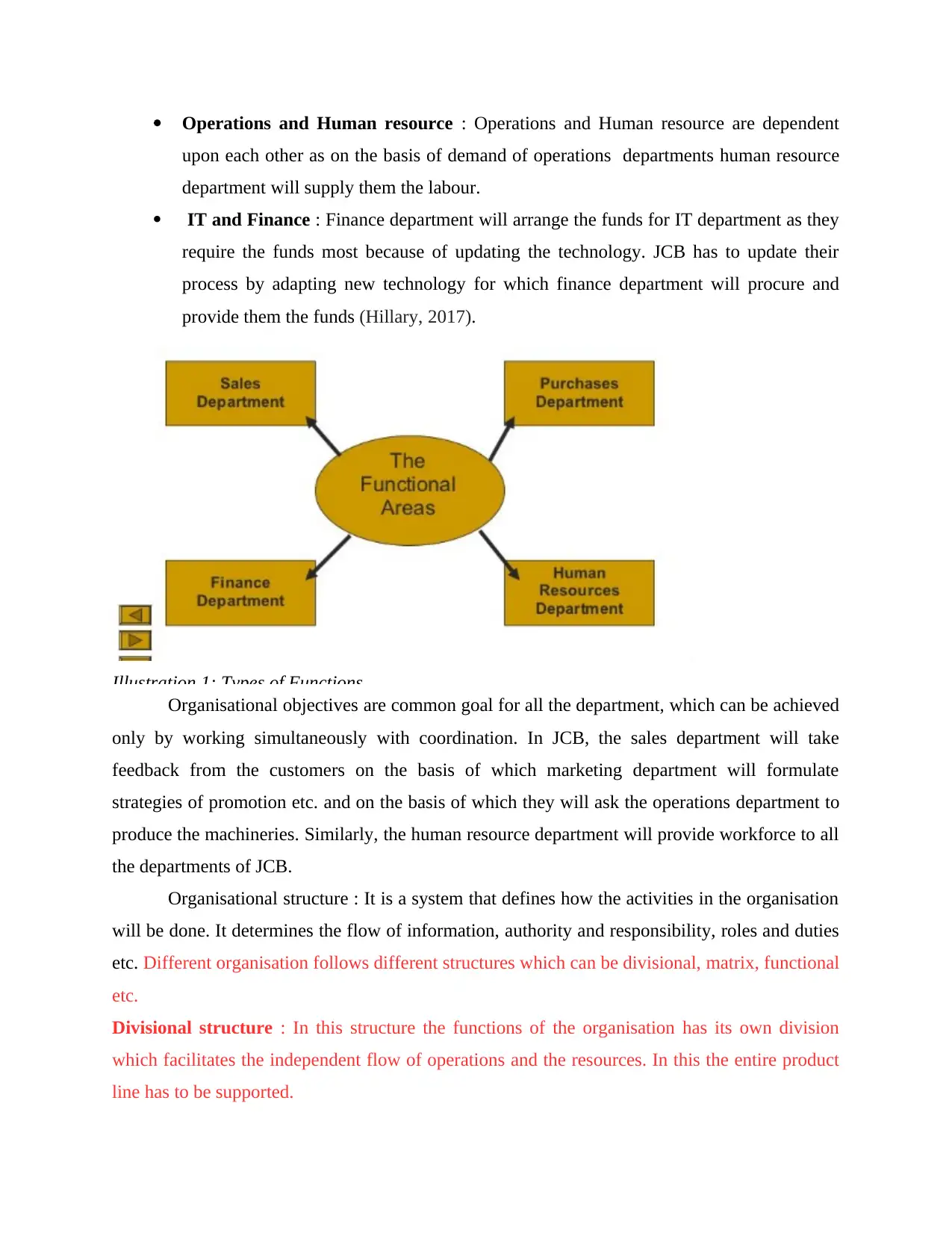
Operations and Human resource : Operations and Human resource are dependent
upon each other as on the basis of demand of operations departments human resource
department will supply them the labour.
IT and Finance : Finance department will arrange the funds for IT department as they
require the funds most because of updating the technology. JCB has to update their
process by adapting new technology for which finance department will procure and
provide them the funds (Hillary, 2017).
Illustration 1: Types of Functions
Organisational objectives are common goal for all the department, which can be achieved
only by working simultaneously with coordination. In JCB, the sales department will take
feedback from the customers on the basis of which marketing department will formulate
strategies of promotion etc. and on the basis of which they will ask the operations department to
produce the machineries. Similarly, the human resource department will provide workforce to all
the departments of JCB.
Organisational structure : It is a system that defines how the activities in the organisation
will be done. It determines the flow of information, authority and responsibility, roles and duties
etc. Different organisation follows different structures which can be divisional, matrix, functional
etc.
Divisional structure : In this structure the functions of the organisation has its own division
which facilitates the independent flow of operations and the resources. In this the entire product
line has to be supported.
upon each other as on the basis of demand of operations departments human resource
department will supply them the labour.
IT and Finance : Finance department will arrange the funds for IT department as they
require the funds most because of updating the technology. JCB has to update their
process by adapting new technology for which finance department will procure and
provide them the funds (Hillary, 2017).
Illustration 1: Types of Functions
Organisational objectives are common goal for all the department, which can be achieved
only by working simultaneously with coordination. In JCB, the sales department will take
feedback from the customers on the basis of which marketing department will formulate
strategies of promotion etc. and on the basis of which they will ask the operations department to
produce the machineries. Similarly, the human resource department will provide workforce to all
the departments of JCB.
Organisational structure : It is a system that defines how the activities in the organisation
will be done. It determines the flow of information, authority and responsibility, roles and duties
etc. Different organisation follows different structures which can be divisional, matrix, functional
etc.
Divisional structure : In this structure the functions of the organisation has its own division
which facilitates the independent flow of operations and the resources. In this the entire product
line has to be supported.
Paraphrase This Document
Need a fresh take? Get an instant paraphrase of this document with our AI Paraphraser
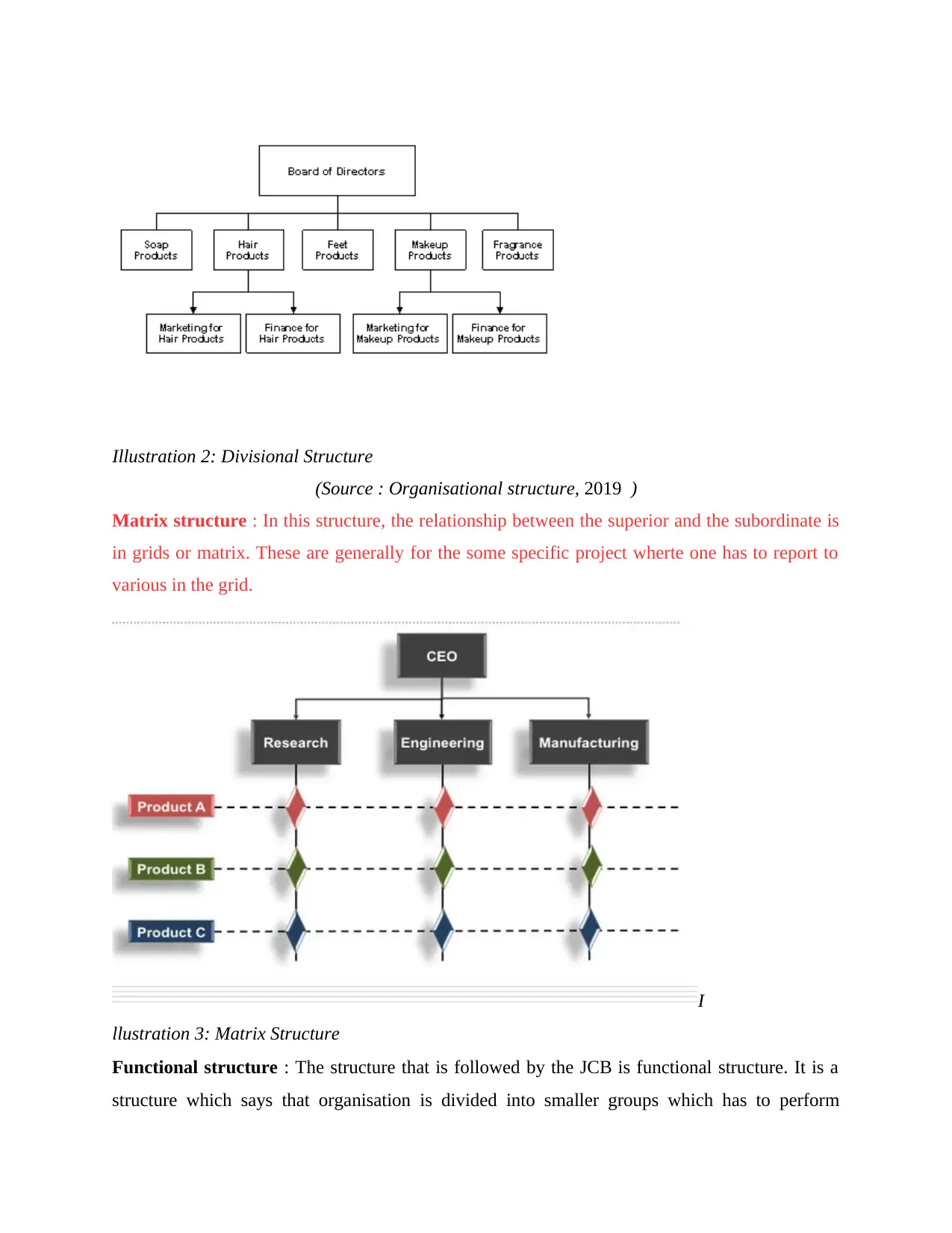
Illustration 2: Divisional Structure
(Source : Organisational structure, 2019 )
Matrix structure : In this structure, the relationship between the superior and the subordinate is
in grids or matrix. These are generally for the some specific project wherte one has to report to
various in the grid.
I
llustration 3: Matrix Structure
Functional structure : The structure that is followed by the JCB is functional structure. It is a
structure which says that organisation is divided into smaller groups which has to perform
(Source : Organisational structure, 2019 )
Matrix structure : In this structure, the relationship between the superior and the subordinate is
in grids or matrix. These are generally for the some specific project wherte one has to report to
various in the grid.
I
llustration 3: Matrix Structure
Functional structure : The structure that is followed by the JCB is functional structure. It is a
structure which says that organisation is divided into smaller groups which has to perform

specific function. Every function has a manager who manages them (Makarova and Polyanin,
2015).
2015).
⊘ This is a preview!⊘
Do you want full access?
Subscribe today to unlock all pages.

Trusted by 1+ million students worldwide
1 out of 21
Related Documents
Your All-in-One AI-Powered Toolkit for Academic Success.
+13062052269
info@desklib.com
Available 24*7 on WhatsApp / Email
![[object Object]](/_next/static/media/star-bottom.7253800d.svg)
Unlock your academic potential
Copyright © 2020–2025 A2Z Services. All Rights Reserved. Developed and managed by ZUCOL.





